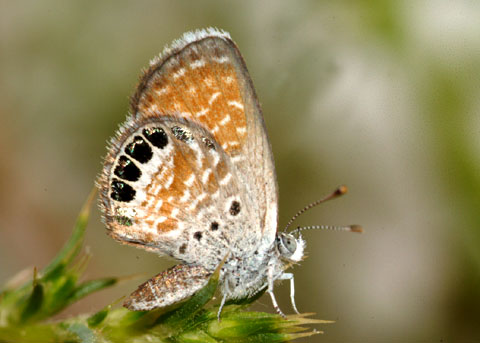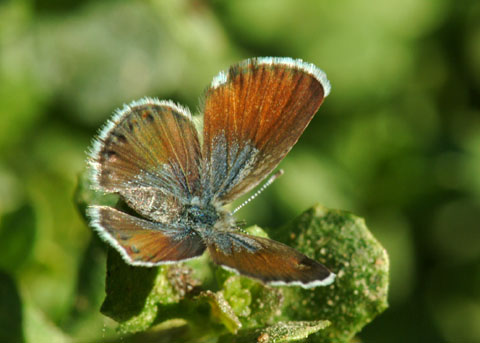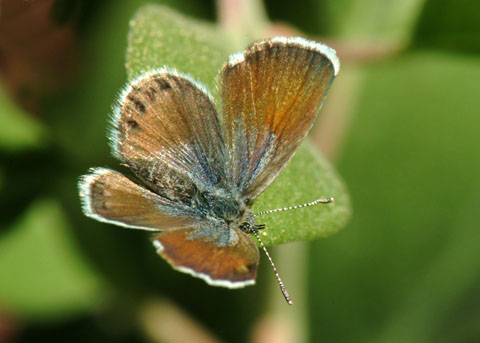 El Moro Canyon, Laguna Beach, Orange County, CA. 09/09/06. © Peter J. Bryant. Contact for originals |
Pygmy Blue Brephidium exilis Lepidoptera: Lycaenidae Back to Butterflies of Orange County, California |
El Moro Canyon, Laguna Beach, Orange County, CA. 09/09/06. © Peter J. Bryant |
 Rancho Santa Ana Botanic Garden, Claremont, Los Angeles County, CA. 11/02/07. © Peter J. Bryant. |
 Rancho Santa Ana Botanic Garden, Claremont, Los Angeles County, CA. 11/02/07. © Peter J. Bryant. |
 Bolsa Chica State Ecological Reserve, Huntington Beach, CA.11/1/09. © Joseph M. Barber. |
 Bolsa Chica State Ecological Reserve, Huntington Beach, CA.11/1/09. © Joseph M. Barber. |
 Bolsa Chica State Ecological Reserve, Huntington Beach, CA.11/1/09. © Joseph M. Barber. |
Characteristics: Our smallest butterfly, and apperently the world's smallest butterfly. Forewing length: 5 -7 mm. Dorsal wing brown, becoming blue near the body. Similar Species: This butterfly should be easily distinguishable from other local lycaenids by its small size. Habitats, Behavior: The Pygmy Blue is almost always seen fluttering weakly about one of the larval foodplants. The species often occurs in large numbers, but is still easily overlooked. Distribution: Brephidium exilis is especially abundant in the coastal areas although it also occurs (less commonly) in the interior areas of Orange County. Any vacant lot or semi-disturbed area containing the foodplant is also likely to harbor populations of the Pygmy Blue. Flight Period: This diminutive species is multiple brooded and may be found throughout the year. It is particularly common during the fall months, e.g. October. Coolidge (1924) states that although found every month of the year, the Pygmy Blue does not "appear in numbers until early July, reaching the apex of the season's flight in the hot days of September, and from the middle of November, or earlier according to the coolness of the season, rapidly diminishing." Larval Foodplants: Many members of the plant family Chenopodiaceae are utilized, although saltbush (Atriplex spp.) are probably most commonly utilized in the deserts and coastal areas of southern California. The Pygmy Blue also utilizes Chenopodium spp. (Goosefoot) and Tumbleweed, also known as Russian Thistle (Salsola iberica). Other Chenopodiaceae are probably also utilized. Coolidge (1924) records Petunia as a larval foodplant at Buena Vista Lake (Kern County). Other Remarks: This is one butterfly whose populations have probably increased greatly since the coming of man and the introduction of weeds (such as tumbleweed), which have been utilized to a great extent by the Pygmy Blue as larval foodplants. The larval foodplant in coastal Orange County is primarily Atriplex, although further inland, Salsola is more typically utilized, due to the scarcity of Atriplex in the interior areas of Orange County. From Orsak, L. J. (1977). The Butterflies of Orange County, California. Center for Pathobiology Miscellaneous Publication #3. University of California Press, New York. 349pp. Return to Butterflies and their larval foodplants |
|
